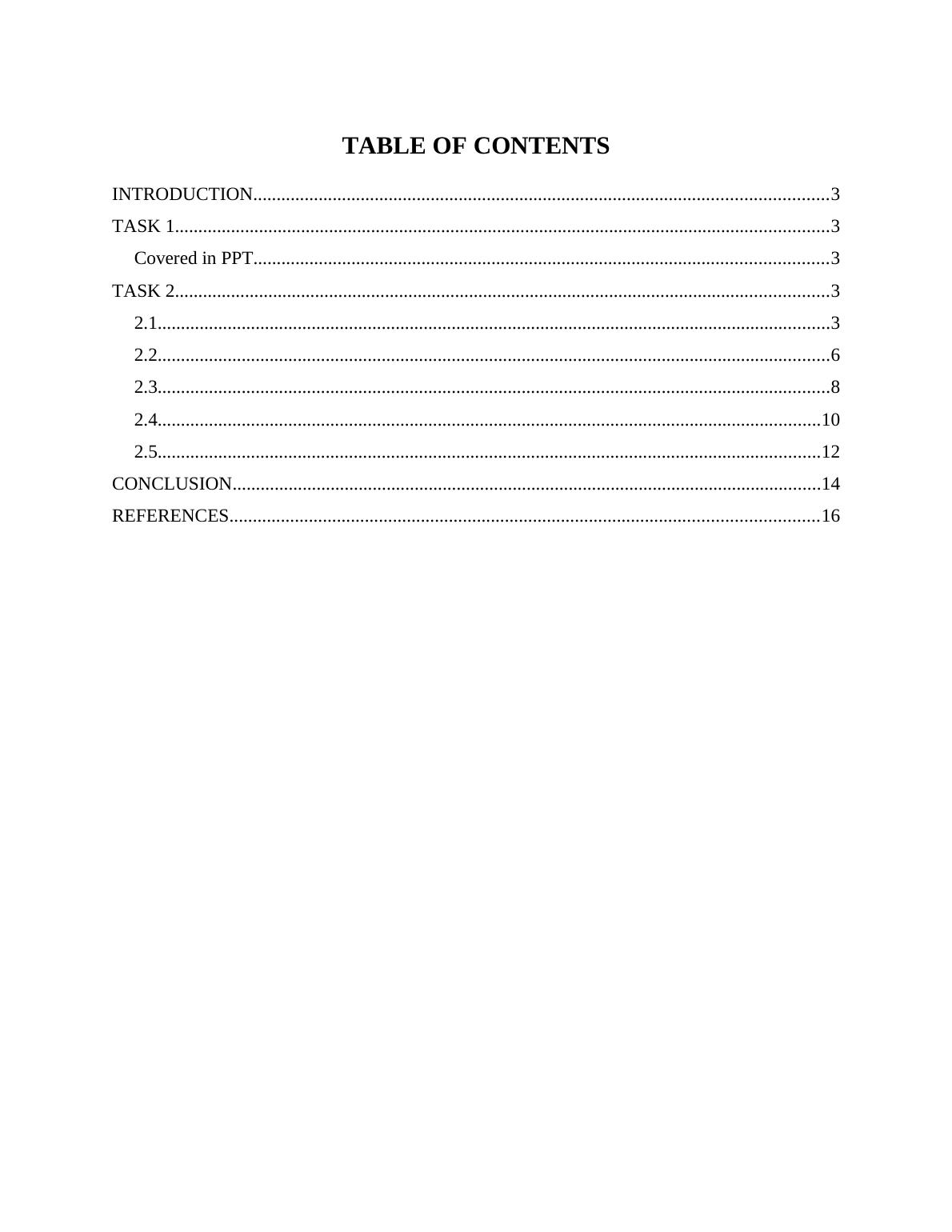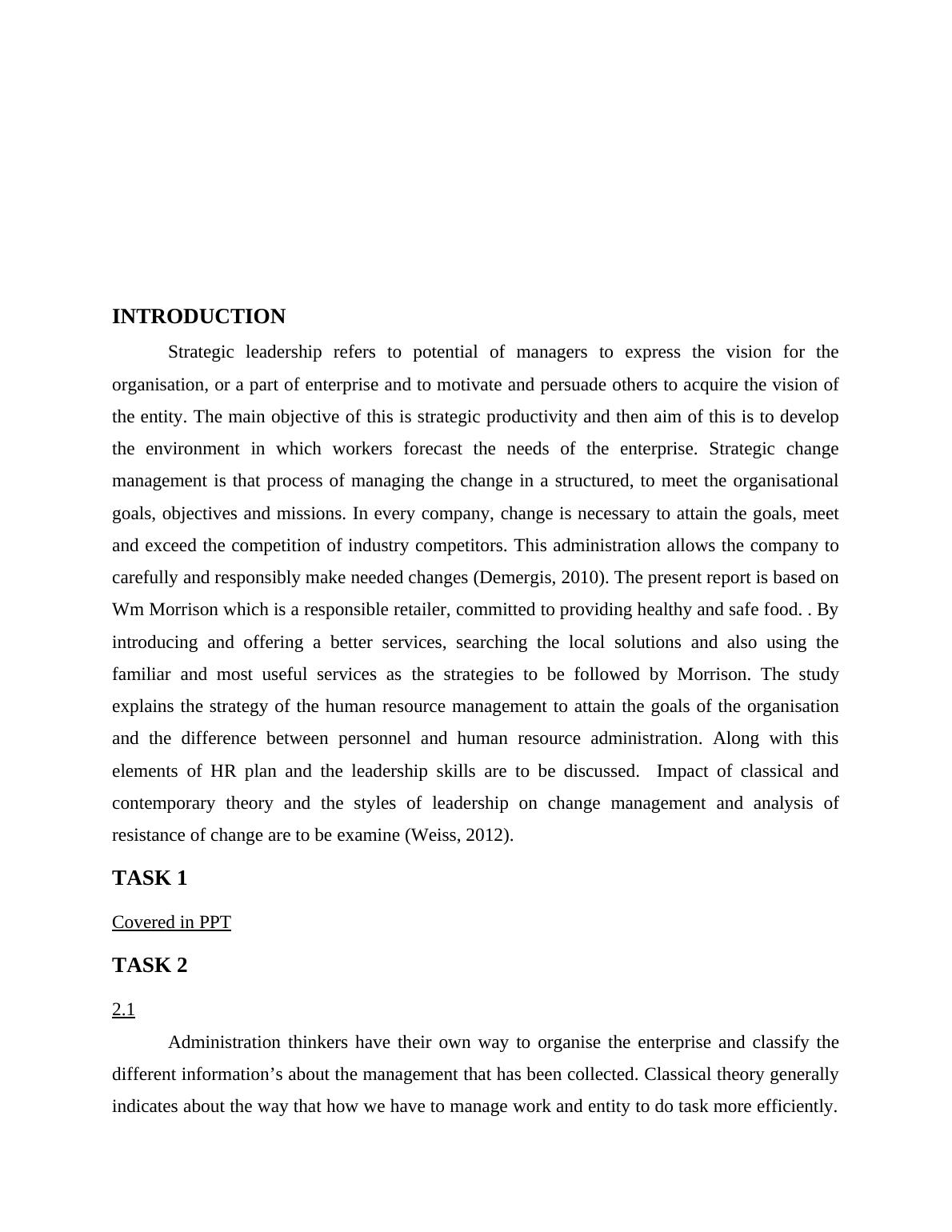Strategic Leadership and Change Management in Enterprise
Added on 2020-01-07
16 Pages5992 Words110 Views
Change Management AndStrategic Leadership

TABLE OF CONTENTSINTRODUCTION...........................................................................................................................3TASK 1............................................................................................................................................3Covered in PPT...........................................................................................................................3TASK 2............................................................................................................................................32.1................................................................................................................................................32.2................................................................................................................................................62.3................................................................................................................................................82.4..............................................................................................................................................102.5..............................................................................................................................................12CONCLUSION..............................................................................................................................14REFERENCES..............................................................................................................................16

INTRODUCTIONStrategic leadership refers to potential of managers to express the vision for theorganisation, or a part of enterprise and to motivate and persuade others to acquire the vision ofthe entity. The main objective of this is strategic productivity and then aim of this is to developthe environment in which workers forecast the needs of the enterprise. Strategic changemanagement is that process of managing the change in a structured, to meet the organisationalgoals, objectives and missions. In every company, change is necessary to attain the goals, meetand exceed the competition of industry competitors. This administration allows the company tocarefully and responsibly make needed changes (Demergis, 2010). The present report is based onWm Morrison which is a responsible retailer, committed to providing healthy and safe food. . Byintroducing and offering a better services, searching the local solutions and also using thefamiliar and most useful services as the strategies to be followed by Morrison. The studyexplains the strategy of the human resource management to attain the goals of the organisationand the difference between personnel and human resource administration. Along with thiselements of HR plan and the leadership skills are to be discussed. Impact of classical andcontemporary theory and the styles of leadership on change management and analysis ofresistance of change are to be examine (Weiss, 2012). TASK 1Covered in PPTTASK 22.1Administration thinkers have their own way to organise the enterprise and classify thedifferent information’s about the management that has been collected. Classical theory generallyindicates about the way that how we have to manage work and entity to do task more efficiently.

Classical theory is divided into three parts. The part generally includes scientific, administrativeand bureaucratic management. Scientific management – It can be defined as the systematic method of work in order to carry outtask more efficiently. It has many principles and among those the first is that it determines thebest method to accomplishing every task. Second one suggests that the workers needs to do workon the basis of their qualification and training provided to them on the jobs. Third part denotesthe cooperation between employers and employees on the basis of self interest. Thisadministration denotes the study of management and enterprise in many areas which includeshuman resource management and engineering of the industries (Kotter, 2014). Administrative Management – It focuses on the process and principles of administration. It isjust contrast to the scientific management, which deals with individual level of analysis andprovides general theory of administration. In this theory, the author gives universal process offunction which includes planning, organising, staffing, directing and controlling. Along with this,it also explains fourteen principles of management which are related to division of work,authority and responsibility, unity of command and team spirit. Bureaucratic Management – It focuses on ideal forms of Morrison. It is characterized by thedivision of labour, hierarchy, formalized rules and the selection along with promotion ofemployees. Further the promotion is entirely based on ability that would lead to give outstandingefforts towards work It is based on the observations and managed with the decisions which isbased on personal relationships and loyalty.Behavioural school of management is based on the human relations and the behavioural scienceand based on the efficiency, process and principles (Kim and Mauborgne, 2013). Quantitativeschool focuses on improvement of decision making. It includes management science, productionand operation management. On the other hand, contingency theory focuses on principles andprocess of administration which is to be applied. It lays emphasis on the best way to manage andit is dependent on various situational factors such as technology, external environment etc. Contemporary school of management – It is a new approach to the study of administration. Ithas briefly categorised with two contemporary approaches that is total quality management andthe learning organisation. Total quality management (TQM) – It is a approach of administration which focuses onmanaging Morrison and to deliver goods and services with better quality. TQM has four major

End of preview
Want to access all the pages? Upload your documents or become a member.
Related Documents
Leadership and Management - Assignment Sample PDFlg...
|9
|2530
|18
Organisational Theory - Assignmentlg...
|11
|2562
|411
Leadership & Management for Service Industrylg...
|14
|4786
|35
Classical Management Theories and Leadership Styles - PDFlg...
|13
|4351
|402
Leadership and Management for Service Industrieslg...
|12
|2300
|105
Leaders and Managers in the Service Sector: Managing Talent Across Different Age Profileslg...
|13
|3944
|25